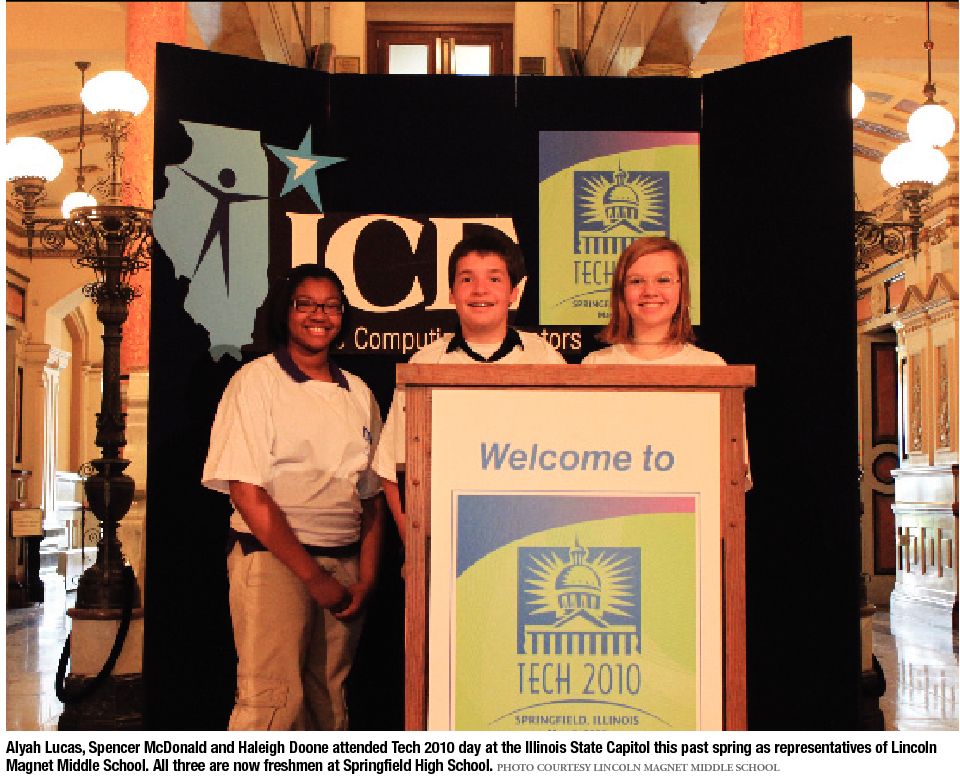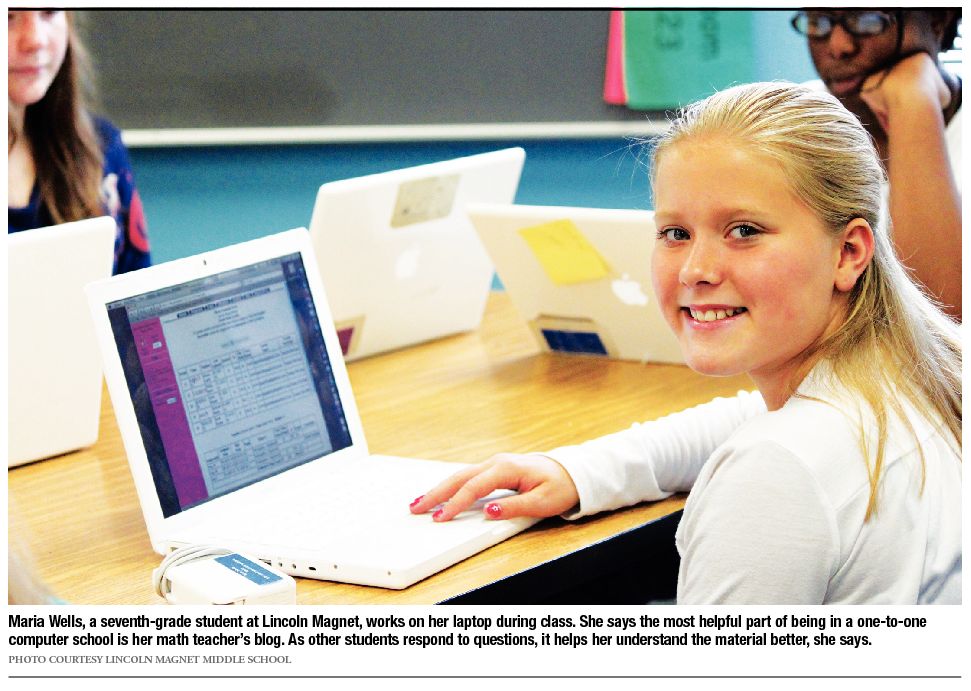
Sixth-grade Lincoln Magnet teacher Melissa Netznik calls today’s students “digital multi-taskers.” “I couldn’t do my homework this way, but my kids have their computer open, they might be texting and over here they’re sending messages and they’re doing this on their homework,” Netznik says. “That’s how their brains work and if we try to teach in a traditional way, we’re missing our kids.”
According to a 2010 Kaiser Family Foundation report entitled “Generation M2,” kids do just what Netznik describes – and they do it a lot. On average, children ages eight to 18 spend about 7.5 recreational hours every day wired in to some type of media, whether staring at a screen, listening to music or, for just 40 minutes each day, reading text on an actual printed page. Of those 7.5 hours, more than three hours are spent doing two or more of those activities at one time.
What exactly digital multi-tasking means for brain development and students’ attention spans is still a matter of debate, but the idea that students respond better to the one-clickaway approach rings true for Lincoln Magnet.
In 2009, 98 percent of Lincoln eighth-graders met or exceeded expectations in reading and 91 percent did so in math on their ISATs [Illinois Standards Achievement Tests]. A look at all Dist. 186 eighth-grade students shows only 68 and 70 percent of students met or exceeded expectations in those areas in 2009.
That same year, 36.5 percent of Lincoln Magnet’s 326 students were classified as lowincome. Of such students, only 2.9 percent of Lincoln Magnet’s low-income eighth-graders failed to meet standards in reading, compared to 41.8 percent of low-income eighth-graders district-wide. In math, 38.8 percent of lowincome eighth-graders failed to meet standards district-wide. At Lincoln Magnet, only 14.7 percent of students in the same subgroup failed to meet standards in math.
“When you look at all of our test scores, there’s not a huge achievement gap because all of our students have access and it breaks the digital divide. All of the students have access, so it’s not separating those who have and those who do not,” says Principal Nichole Heyen. While not all Lincoln Magnet students have access to the Internet at home – a 2009 U.S. Census Bureau survey shows that about 26 percent of U.S. children aged three
to 17 do not – they are still able to use their computers for other interactive programs and to access stored research files.
Heyen credits technology as the most significant factor in her students’ test scores, but it’s just one of the elements playing a role in Lincoln Magnet students’ education.
Lincoln Magnet is a “choice” school, meaning parents must fill out an application in order for their children’s names to be put in a lottery drawing for the limited seats available in each sixth-grade class.
“I think it’s a dual thing,” says Sue Ruff, the district’s director of technology. “You see a lot of student engagement because of the technology, but also at Lincoln Magnet you have the piece where … families took on the responsibility to get their children there. So you have a lot of parental support.”
Former Lincoln Magnet student Matt Medley, now a freshman at Springfield’s Southeast High School, agrees family involvement played a role in his and his fellow students’ success. “Parental encouragement – there’s no substitute for it,” he says. But he adds that technology played just as important of a role.
Ball Charter, like Lincoln, is a choice school and had a low-income rate of about 40 percent in 2009, compared to Lincoln’s 36.5 percent. It fared better on standardized testing than the other district middle schools, and that year’s eighth-graders outpaced Lincoln’s by 3 percent in math. However, Ball

Charter had a smaller
proportion of eighthgrade students meeting and exceeding standards in
both reading, 77 percent compared to Lincoln’s 98 percent, and writing,
66 percent compared to Lincoln’s 84 percent.
“I’m
not saying that [technology] is the only reason their test scores are
higher, but that’s got to be one of the reasons,” Wise says, adding that
the smaller population at Lincoln Magnet might help foster better
faculty-student relationships. “Test scores aren’t determined by one
factor. There are a whole lot of factors that go into how well a student
performs.”
Medley
says his move to Southeast High School, without the one-to-one computer
access, was a bit of a culture shock, but he’s still making the grade.
“It’s kind of a difficult switch. A lot of it fell on me personally to
adapt, which I did. So, for me personally, it hasn’t been a horrible
change. And the teachers at Lincoln didn’t try to eliminate paper and
pencil completely because there would be that kind of lapse no matter
what high school you went to,” he says.
 Medley
says about Southeast: “On a comparative basis this school is
technologically deprived.” Ruff, Heyen and Netznik say Medley’s response
parallels what they hear from most former Lincoln Magnet students, but
they add that most are able to adjust and that their new teachers are
usually flexible in allowing them to use their advanced technological
skills when creating projects.
Medley
says about Southeast: “On a comparative basis this school is
technologically deprived.” Ruff, Heyen and Netznik say Medley’s response
parallels what they hear from most former Lincoln Magnet students, but
they add that most are able to adjust and that their new teachers are
usually flexible in allowing them to use their advanced technological
skills when creating projects.
Principal
Heyen adds that the absence of one-to-one doesn’t mean technology can’t
be effectively integrated into the classroom. “Our school started with
not a one-to-one. So you can still provide all of these opportunities
with one computer, one projector,” she says.
While Lincoln Magnet enjoys its one-to one
student-computer
ratio, the rest of the district has about a four-to-one ratio, Ruff
says. If all of those computers were working, the school would be about
on par with the rest of the nation, according to 2006 U.S. Census Bureau
figures. But so many of the computers are old enough that teachers,
when developing their lesson plans, can’t count on the machines to be
working when they pull them out during class. The new computers
purchased through the recent Apple contract should solve that problem, Ruff says.
Many
teachers at Medley’s high school already manage to incorporate
technology into their lessons on a regular basis. While their students
don’t have daily access to laptops, shared computer carts allow students
temporary one-to-one experiences and projectors hooked up to teachers’
computers still allow educators to bring the world to the classroom.
 But just having the
equipment isn’t enough. According to a series of reports on one-to-one
classrooms published in the January edition of the Journal of Technology, Learning and Assessment, technology’s
impact on education outcomes is not a matter of just having computers
in the classroom, it’s a matter of how comfortable teachers and
administrators are with using technology and how they actually use it.
But just having the
equipment isn’t enough. According to a series of reports on one-to-one
classrooms published in the January edition of the Journal of Technology, Learning and Assessment, technology’s
impact on education outcomes is not a matter of just having computers
in the classroom, it’s a matter of how comfortable teachers and
administrators are with using technology and how they actually use it.
Zimmers
taught at Grant Middle School before she came to Lincoln Magnet. She
says there was a definite difference in culture between the two schools.
“Not every teacher has the background in technology, not that they
don’t want to use it in any of the other middle schools, they just don’t
have that foundation to expand. They’re still learning all of the
applications, how to integrate it, so I think that’s a spot to grow
upon.”
Ruff hopes
the 450-plus hours of training Apple will provide teachers as part of
the new equipment contract will also encourage them to use the
technology as a tool for engaging students as they share their subject
expertise.
“It’s
never technology for the sake of technology. It’s to enhance the
curriculum,” Netznik says. “It’s not about learning the applications,
it’s about learning that higher level thinking. … Technology is just one
of those tools to do that.”
The
district also already employs seven technology instructional leaders
(TILs), educators who make sure teachers know what’s possible when it
comes to integrating technology into the classroom. Like the number of
computers in the schools, seven TILs aren’t as
many
as Ruff would like the district to have, but the current number is an
improvement over the one TIL left after a referendum failed in 2001 and
the district cut back. The district also employs six technicians charged
with managing the district’s networks.
Ruff
says one-to-one computers for the whole district, which seeks to
educate more than 14,000 students, isn’t financially feasible. She adds
that more technology would be great, but she thinks the district as a
whole is doing relatively well with integrating computers right now. “If
you look at our other schools, they’re doing equally great things. … Is
it happening in every single room? No, because the computers are not
available.”
Wise
says she doesn’t know whether even more technology would benefit the
district but adds that “more use of it is needed” if the district wants
Lincoln Magnet’s success mirrored at other schools.
Heyen
says the success Lincoln Magnet is having is more than just high test
scores. It’s getting students to take responsibility for their own
educations and encouraging their curiosity.
“Our
students don’t know what it’s like not to have information,” Heyen says
of her Lincoln Magnet learners. “If they don’t know what a word is,
they’re looking it up on their widget, answering it and moving on.
Before, they would have been stuck waiting for support. Now, they’re
supporting themselves; they’re really taking charge and taking on a lot
more responsibility. They’re just on it all the time. They’re always
learning.”
Contact Rachel Wells at [email protected].